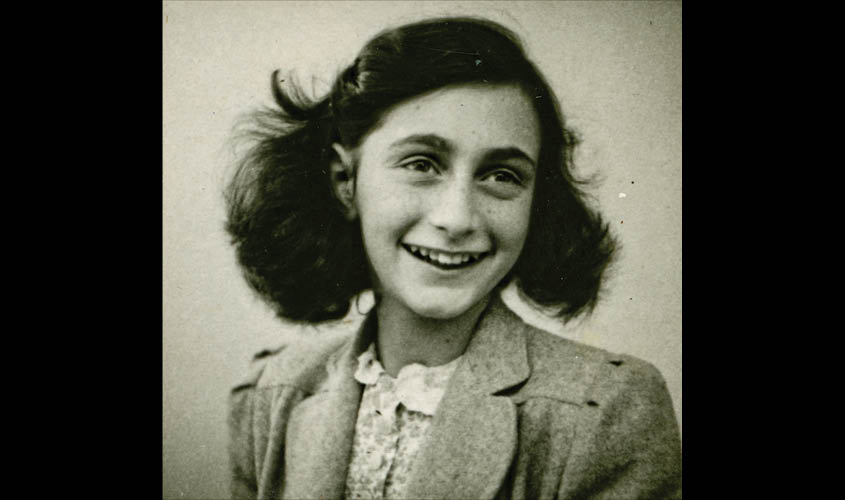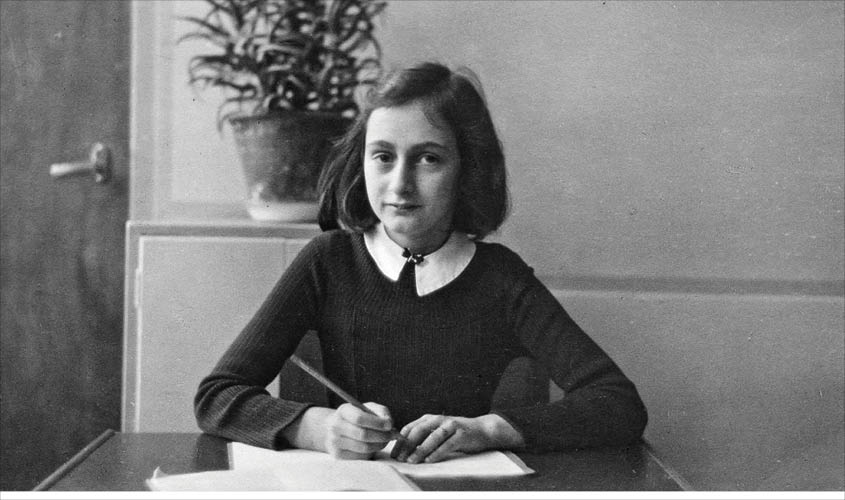Anne Frank spent the last years of her life in hiding, cooped up with her family in a secret annexe in an Amsterdam office building. In August 1944, she was captured by the Nazis, deported to a concentration camp and soon died of an illness. Today, she is remembered around the world as a symbol of hope and her diary is ranked among the classics of world literature. Bhumika Popli writes about the Anne Frank exhibition in Delhi.
“Although I’m only fourteen, I know quite well what I want, I know who is right and who is wrong. I have my opinions, my own ideas and principles, and although it may sound pretty mad from an adolescent, I feel more of a person than a child, I feel quite independent of anyone,” goes Anne Frank’s diary entry for Friday, 17 March 1944, a few months before she was captured by the Nazis.
Anne Frank’s The Diary of a Young Girl is now among the best-known texts to emerge out of the rubble heap of the Holocaust. It has been translated into more than 60 languages. Readers across generations have cherished it because the thoughts recorded in these pages seem to come not so much from a teenager as from a “person” of great maturity and moral authority.
Hounded out of Germany by the Nazis, many German Jews sought refuge in neighbouring countries in those dark years. Anne and her family were part of the same exodus. But even their new home, Amsterdam, ceased to be a safe haven soon after the invasion of Hitler’s forces in 1940. From 9 July 1942 to 4 August 1944, the Frank family lived in hiding, in a secret annexe—“in the building where,” as Anne wrote, “Daddy has his office”— protected by non-Jewish Dutch workers.

Through these two years, Anne documented the ordinary aspects and emotional upheavals of her life. She wrote about routine occurrences, as well as about friendship, love, desire and ambition. “My greatest wish,” she wrote, “is to be a journalist, and later on, a famous writer.”
The title she had in mind for the book she dreamed of publishing one day was The Secret Annexe. The book did come out, as The Diary of a Young Girl, but it followed the nightmare fate of the Frank family’s arrest and deportation at the hands of the Nazis. Anne was sent to the Bergen-Belson concentration camp, where she died of typhus at the age of 15. Everyone in the family perished, except Anne’s father, Otto Frank, the man responsible for the eventual publication of the diary.
The life and diary of Anne Frank are at the centre of an ongoing exhibition in Delhi, entitled Anne Frank: A History for Today. The show is on view at the India International Centre. Displayed here are Anne’s photographs and some text panels from her diary. A short film on her life is also being screened at the venue.
The photos are arranged chronologically, from Anne’s childhood through to her adolescent years. She is pictured at various settings, posing with friends and relations—at her school, with her sister Margot, with her parents and so on.

A few photos of the secret annexe, where the Frank family was hiding, are also here. In one of the images we can see the room Anne shared with a family friend who had gone into hiding with them. The room, with its walls covered in many photographs, has two beds and a desk where Anne used to write her diary.
The images transport us to a past that subsequent generations have found difficult to reckon with. One of the aims of this exhibition is to re-establish the relevance of that past, and of Anne Frank’s sacrifice, to our time today.
“Anne Frank’s story is as important today as it was when her diary first surfaced years ago,” according to a statement by the Netherlands Embassy in India, which has co-organised the exhibition with the Anne Frank House and PeaceWorks, an initiative of the Seagull Foundation for the Arts. “Even after so many years, Anne’s story of resilience, faith and love in the face of conflict encourages us to be hopeful and optimistic in the toughest of situations. Her story is one of world’s most popularly read personal accounts of the atrocities of war comprising details of the disturbing events that unfolded during the Second World War. When you read Anne Frank’s story, you’re also gaining knowledge about the importance of hope, tolerance and non-discrimination—all of which are extremely important in the contemporary context.”
The original copy of Anne’s diary, bound in a red-and-white plaid cover, is the subject of one the photographs displayed at the show. She had received this diary as a present on her 13th birthday and immediately started confiding her deepest thoughts to it. “I want to write, but more than that, I want to bring out all kinds of things that lie buried in my heart,” she wrote, just a few days after her 13th birthday.

“Anne Frank’s diary isn’t just a story of a young girl, but an account that helps us gain a deeper understanding of an event that shaped world history. We often ignore the important role our history has played in shaping our lives, but only when we acknowledge past events can we move forward towards creating a present that’s truly peaceful and equal. The exhibition also encourages us to be tolerant and deal with the many challenges the world faces today. It is also important to have discussions about the Holocaust and its associated human rights facets—especially with our younger generation today—so they can lead us into a peaceful, tolerant world free that celebrates diversity,” according to the embassy statement.
The disturbing reality of the Holocaust is intertwined with Anne Frank’s life and is the principal theme of the Delhi show. Horrifying visuals of strife and suffering from WWII are everywhere: images of poison gas canisters, people at concentration camps waiting in line to be executed, children being examined for their racial traits.
Alongside these, the text panels add to our understanding of how the Jews of Europe—as well as the gypsies, the homosexuals, the elderly and the sick—were being systematically wiped out by the Nazis. The picture of a typed-out note, which looks like an invoice but is actually the work of a Nazi statistician recording the number of Jews residing across Europe, is a terrifying symbol.

On one of the panels, we read these words from Anne’s diary, almost but not quite spelling the end of hope: “It is impossible to escape the clutches unless you go into hiding. No one is spared.”
On another text panel, we read the words of Anne’s school friend, Hannah Gosler, who was in the same concentration camp as Anne and survived the Holocaust: “She wasn’t the same Anne. She was a broken girl…it was terrible. She immediately began to cry, and she told me: ‘I don’t have parents anymore.’ I always think if Anne had known that her father was still alive, she might have found the strength to survive…”
Anne Frank is considered a symbol hope around the world. About Anne’s diary, the former first lady of the United States, Eleanor Roosevelt, once said, “One of the wisest and most moving commentaries on war and its impact on human beings that I have ever read.”
One can also find innumerable references to Anne Frank in pop culture. Geoff Ryman in his novel 253, brings an elderly Anne Frank as a passenger on the London tube. Grigory Frid composed an operatic piece around the diary. Artist Marc Chagall illustrated a limited edition of The Diary of a Young Girl. There’s also an asteroid named after her: 5535 Annefrank.
The 28-min documentary screened at the venue is directed by Gerrit Netten. The film includes the only known footage of Anne Frank, taken in 1941, as well as footage of Otto Frank from the 1960s.
PeaceWorks has been the India partner of the Anne Frank House since 2013. Its aim is to reach out to students and teachers across the country and connect them with the writings of Anne Frank.
“Through this exhibition, the idea is to help students in connecting the dots between the Holocaust and its relation to the present times. It is very easy in contemporary India, or in fact anywhere in the world, to instigate groups or individuals against each other on the issues of caste, religion and so on. Nothing has really changed since the past 70 years in India,” says Megha Malhotra, director of the Seagull Foundation for the Arts.
The embassy spokesperson, too, emphasised this point about popularising Anne Frank’s diary among India’s youth: “While it is interesting and relevant for all age-groups, this educational exhibition especially aims to engage with the Indian youth. With a huge proportion of population under 25 years of age, India’s youth has the power to shape our future; imbibing values of tolerance and equality in our future leaders thus becomes very important. The exhibition aims to enable its visitors in relating to Anne Frank’s hopes and dreams, and doing their bit in creating a peaceful, equal world driven by mutual respect.”

